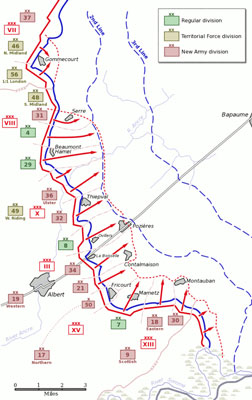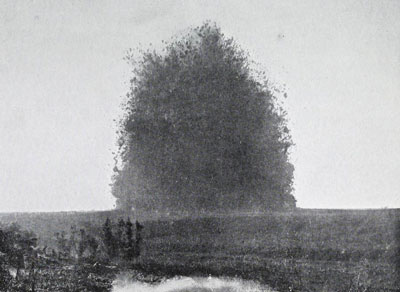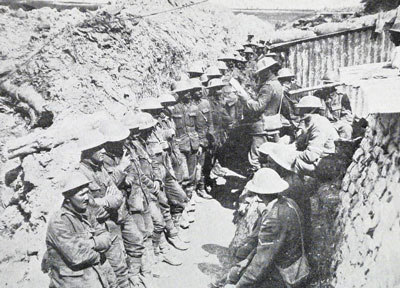
WWII: Maginot Line | Normandy | V-Weapon Sites | Arnhem
Further afield: Crete
| Home Tracing Military Ancestors Travel Advice CWGC Cemeteries Iron Harvest News Book Reviews Glossary Links Contact Me The Somme:
 
|
First of July 1916The first day of the Battle of the Somme was the single bloodiest day in the history of the British Army and arguably the darkest day in the history of Great Britain.
As the bombardment lifted and the young conscripts of the new armies climbed out of their trenches and moved across no-man's-land, it became clear that the bombardment had not neutralised the German defenders in the front line trenches. Nor had it knocked out the German artillery. Despite the use of a number of explosive mines codenamed "Hawthorn" at Beaumont Hamel and "Y Sap" and "Lochnagar" at La Boisselle to destroy heavily defended German redoubts, the attack faltered almost everywhere as the Germans raced from their dugouts to man the parapets.
Almost everywhere the Germans reached their positions and began firing long before the British had got to the German wire. Machine-gun and rifle bullets began to scythe through the waves of British infantry. The ineffectiveness of the artillery bombardment now became clear as the attacking waves made for the few gaps in the wire that had been cut. German machine-gun teams simply directed their aim at the gaps. Their artillery then rained down on the British front line catching reserves and wounded from the first wave. It was nothing short of a catastrophe and a massacre. North of the River Ancre, a diversionary attack by General Allenby's Third Army at Gommecourt involving the 56th London and 46th North Midlands Divisions was stopped in its tracks. To their right, advances by the 31st, 4th and 29th Divisions of the VIII Corps between Serre and Beaumont Hamel, also came to nought with horrifying casualties. Up on the ridge between Thiepval and the Ancre the 36th Ulster Division charged through the first two German defence lines and into the network of trenches known as the Schwaben Redoubt but, with attacks on either flank failing, could not hold onto its gains and was pushed back. Meanwhile, at La Boisselle, the 34th Division took the heaviest casualties of all the attacking units with 6,380 killed and wounded in just a few hours – effectively destroying the division as a fighting force. Only in the south, adjoining the French, did anything resemble a success. Here the British benefited from the fire of more abundant French heavy guns handled with the experience gained in the 1915 battles in Artois and Champagne and, of course, the continuing battle of Verdun. Also more astute divisional commanders, such as Major-General Ivor Maxse of the 18th Eastern Division, had trained their New Army troops more thoroughly and were ready to use more innovations. These included the integrated use of liquid flame projectors, mines and Russian saps (sub-surface trenches dug towards the enemy lines to protect attacking troops then blown out with explosives), with the assault troops. Here the villages of Mametz and Montauban and later Fricourt, were taken with generally lower loss of life – although the experiences of individual battalions were varied. The highest single unit loss along the whole front on 1st July was that of the 10th West Yorkshires at Fricourt who lost a staggering 710 men out of 800. Meanwhile the French, with a crushing weight of heavy artillery firing high explosive rounds and aided by early river mist either side of the Somme, made good ground with fairly light casualties. Altogether the British Army suffered nearly 60,000 casualties on this first day of whom 19,000 were dead. The sheer numbers of wounded overwhelmed advanced dressing and casualty clearing stations. Due to the nature of the enlistment of the volunteers many had joined so-called "pals" battalions. Thus friends and work colleagues who had joined up together and trained together, attacked together and ultimately died together. The impact on their local communities was catastrophic, particularly in the towns and villages of the industrial north where so many of the young men had enlisted.
|


